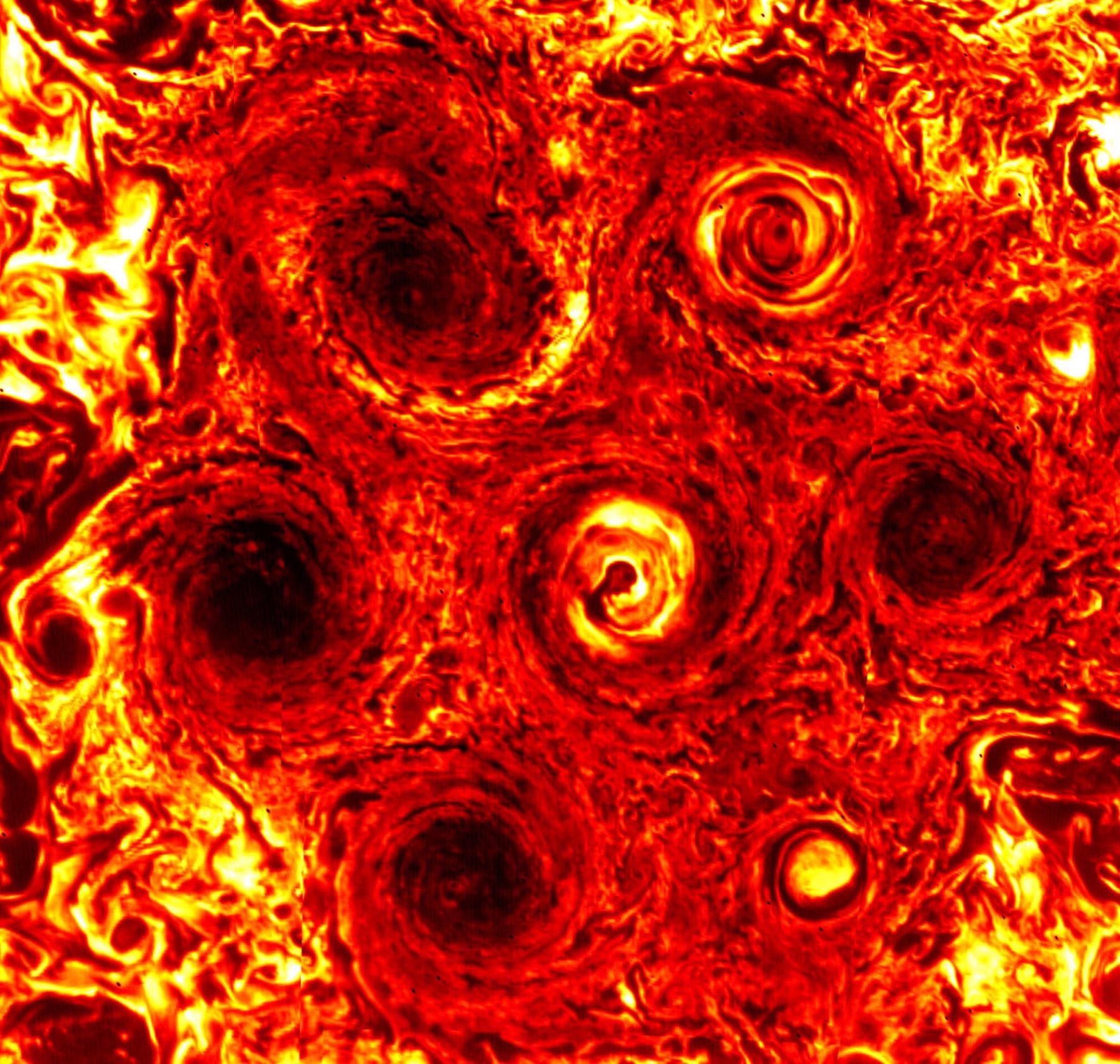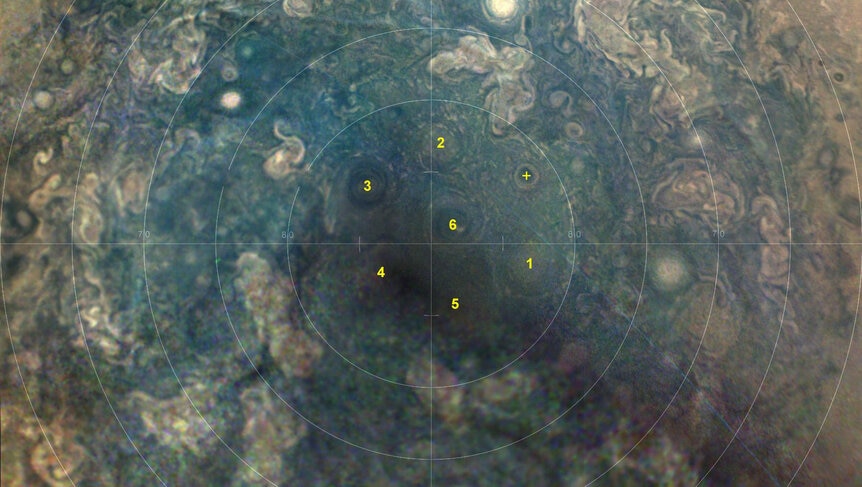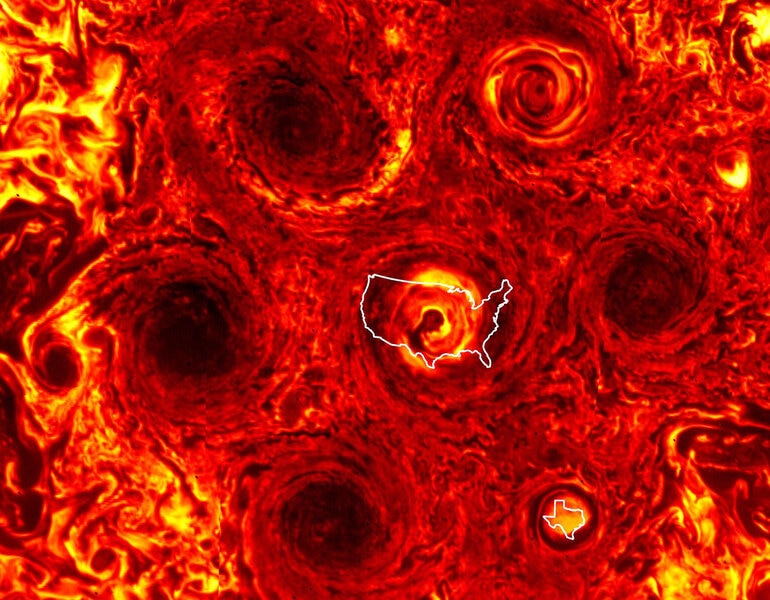Create a free profile to get unlimited access to exclusive videos, sweepstakes, and more!
Jupiter is still *really* weird: A new monster storm has formed around its south pole

If there's one thing you should know about Jupiter, it’s that it's weird.
I mean really, really weird.
We know this because we've seen it close up. NASA's Juno probe entered into a long, looping, elliptical orbit around the ridiculously huge planet on 4 July 2016, taking about 53 days to orbit it once. It goes out as far as 8 million kilometers from Jupiter, but when it drops down on the planet it drops down: It plunges over the south pole of Jupiter at a height of a little over 4,000 km above the cloud tops, screaming past at a whopping 200,000 kilometers per hour!
The purpose of the mission is to investigate the upper atmosphere and environment around Jupiter, to help us understand the gas giant's interior. Jupiter is 70,000 km in radius, but we only see the very tops of the clouds with visible light. One camera on board is JIRAM, the Juno InfraRed Auroral Mapper. It's sensitive to far-infrared light, which you can think of as heat. Jupiter's deeper atmosphere is warmer, and that heat leaks out, so JIRAM gives us clues about what's happening deeper down.
When Juno flew over the planet's south pole during its fourth perijove (closest approach to Jupiter, not counting the very first one when the spacecraft maneuvered into orbit around the planet) on 2 February, 2017, it saw something unexpected: A cyclone over 5,000 km across right over the pole, surrounded by five other cyclones ranging from 5,600 to 7,000 kilometers across! Not only that, the five cyclones were arranged in a pretty decently regular pentagon.
It's bizarre. But now things have gotten bizarrer. On its last pass (Perijove 23) on 3 November, 2019, it delivered another big surprise: A sixth cyclone has joined the other five surrounding the pole!
What. The. WHAT.
This is an infrared image, so brighter spots are warmer… though the warmest gas here is about -10°C, and the coldest -80°, so warm is relative.
Mind you, wind patterns near the poles of planets do get odd. Regular geometric patterns are a natural outcome of winds blowing through a spinning atmosphere near the poles; Saturn has that incredible hexagon, and even Earth has similar patterns. But those are overall, general patterns; here we have individual storm systems distributed geometrically, and it's just so strange to see them like that!
Of course, this is natural too.
… but that doesn't mean it's understood. At the moment, it's not clear why this happens. There must be some sort of stability generated when these systems migrate to the poles; I'd guess it's similar to what happens when vortices stabilize themselves in water. I'm guessing though.
Whatever it is, it also has to allow for new cyclones to move in and set up shop, as this new one has done. As you can see in the image it's not quite as big and well organized as its brethren, but we'll see what happens over time.
Note that something similar is going on at Jupiter's north pole, except it's nine cyclones, with a ring of eight surrounding the central one. They're also arranged like two overlapping squares, too: Four of the surrounding cyclones are bigger and better organized than the other four, and at a slightly different latitude. It's very strange.
By the way, wind speeds in those cyclones have been clocked at over 360 kph! That would be at the top end of the tornado scale here on Earth, so yikes. Jupiter does everything big.
Hopefully, these new images (and perhaps ones taken on later orbits) will give scientists some ideas of the hydrodynamics going on at Jupiter’s poles. In a sense we're lucky to have this data at all: Engineers realized that on this pass Juno would go through Jupiter's shadow for 12 hours, and given that it's a solar powered spacecraft, that would be bad. Without power to warm the electronics they could drop so much in temperature they’d be damaged.
So, the team commanded the spacecraft to use its reaction control system in an unusual way, burning those engines for over 10 hours to change the trajectory of the spacecraft (normally the RCS is for much smaller maneuvers, like changing the direction the spacecraft is pointed). This was done on 30 September and changed the path of Juno enough that it stayed in sunlight during this entire perijove event.
Juno is doing a lot to answer some of the questions scientists have about the largest planet in our solar system, but — as is typical with any exploration like this — it's also laying at our feet a lot of other new mysteries we have yet to solve. But ask any scientist: They wouldn't have it any other way.
And if Jupiter is weird? Great! We love weird.





























